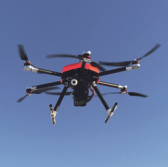 A QinetiQ subsidiary has helped the Canadian navy conduct a live demonstration to simulate potential threats multi-rotor drones could pose to naval vessels.
A QinetiQ subsidiary has helped the Canadian navy conduct a live demonstration to simulate potential threats multi-rotor drones could pose to naval vessels.
QinetiQ Target Systems demonstrated a rotary-wing target onboard a Halifax-class frigate for the military branch in November as part of a $6.6 million Unmanned Targets Repair, Overhaul and Engineering contract awarded in 2015, the company said Nov. 30.
“Commercially available technologies, like off-the-shelf drones, are becoming more advanced and more accessible to those who wish to use them to cause harm,” said Peter Longstaff, managing director of QTS.
“QinetiQ simulates these new and emerging threats to help the armed forces understand how to protect their people and assets,” Longstaff added.
The company utilized its Universal Target Control Station to operate the Snyper multirotor target in conjunction with Lockheed Martin‘s Indago quadcopter.
UTCS is designed to function as a central command center for multiple unmanned systems.
The Royal Canadian Navy has used the station over the past 20 years to operate various fixed-wing aerial and marine surface targets, QinetiQ noted.
QinetiQ also developed a radar technology designed to identify small or micro drones and the company is part of the Dragonfire industry consortium that is developing a laser directed energy weapon that will work to engage drones in mid-flight.




